Fluidal Peperites Recorded in the Cretaceous Lacustrine Sediments in the Southern Korean Peninsula: Syn-Magmatic Sediment Fluidization and Its Influence on the Peperite Formation
Abstract
1. Introduction
2. Geological Background
3. Methods
4. Results
4.1. Host Sediments
4.2. Magmatic Dikes
4.3. Clastic Dikes
4.4. Peperite Zones
4.5. Formative Processes of Peperites and Clastic Dikes
5. Discussion
6. Conclusions
Author Contributions
Funding
Data Availability Statement
Acknowledgments
Conflicts of Interest
References
- Busby-Spera, C.J.; White, J.D.L. Variation in peperite textures associated with differing host-sediment properties. Bull. Volcanol. 1987, 49, 765–775. [Google Scholar] [CrossRef]
- McPhie, J.; Doyle, M.; Allen, R. Volcanic Textures: A Guide to the Interpretation of Textures in Volcanic Rocks; University of Tasmania: Hobart, Australia, 1993; p. 196. [Google Scholar]
- Skilling, I.P.; White, J.D.L.; McPhie, J. Peperite: A review of magma-sediment mingling. J. Volcanol. Geotherm. Res. 2002, 114, 1–17. [Google Scholar] [CrossRef]
- White, J.D.L. Impure coolants and interaction dynamics of phreatomagmatic eruptions. J. Volcanol. Geotherm. Res. 1996, 74, 155–170. [Google Scholar] [CrossRef]
- Zimanowski, B.; Büttner, R.; Lorenz, V. Premixing of magma and water in MFCI experiments. Bull. Volcanol. 1997, 58, 491–495. [Google Scholar] [CrossRef]
- Owen, G. Deformation processes in unconsolidated sands. In Deformation of Sediments and Sedimentary Rocks; Jones, M.E., Preston, R.M.F., Eds.; Geological Society Special Publication: London, UK, 1987; Volume 29, pp. 11–24. [Google Scholar]
- Goto, Y.; McPhie, J. A Miocene basanite peperitic dyke at Stanley, northwestern Tasmania, Australia. J. Volcanol. Geotherm. Res. 1996, 74, 111–120. [Google Scholar] [CrossRef]
- Roche, O.; Druitt, T.H.; Cas, R.A.F. Experimental aqueous fluidization of ignimbrite. J. Volcanol. Geotherm. Res. 2001, 112, 267–280. [Google Scholar] [CrossRef]
- Doyle, M.G. Clast shape and textural associations in peperite as a guide to hydromagmatic interactions: Upper Permian basaltic and basaltic andesite examples from Kiama, Australia. Aust. J. Earth Sci. 2000, 47, 167–177. [Google Scholar] [CrossRef]
- Squire, R.J.; McPhie, J. Characteristics and origin of peperite involving coarse grained host sediment. J. Volcanol. Geotherm. Res. 2002, 114, 45–61. [Google Scholar] [CrossRef]
- Martin, U.; Németh, K. Blocky versus fluidal peperite textures developed in volcanic conduits, vents and crater lakes of phreatomagmatic volcanoes in Mio/Pliocene volcanic fields of Western Hungary. J. Volcanol. Geotherm. Res. 2007, 159, 164–178. [Google Scholar] [CrossRef]
- Kwon, C.W.; Gihm, Y.S. Fluidization of host sediments and its impacts on peperites forming processes, the Cretaceous Buan Volcanics, Korea. J. Volcanol. Geotherm. Res. 2017, 341, 84–93. [Google Scholar] [CrossRef]
- Liu, L.; Liu, L.; Xu, Y. Mesozoic intraplate tectonism of East Asia due to flat subduction of a composite terrane slab. Earth-Sci. Rev. 2021, 214, 103505. [Google Scholar] [CrossRef]
- Wang, Z.; Liu, L.; Fu, Y.; Zhao, L.; Lin, J.; Jin, Z.; Zheng, B. Multistage plate subduction controls intraplate volcanism and cratonic lithospheric thinning in Northeast Asia. Earth-Sci. Rev. 2023, 246, 104590. [Google Scholar] [CrossRef]
- Liu, K.; Zhang, J.; Xiao, W.; Wilde, S.A.; Alexandrov, I. A review of magmatism and deformation history along the NE Asian margin from ca. 95 to 30 Ma: Transition from the Izanagi to Pacific plate subduction in the early Cenozoic. Earth-Sci. Rev. 2020, 209, 103317. [Google Scholar] [CrossRef]
- Chough, S.-K.; Sohn, Y.-K. Tectonic and sedimentary evolution of a Cretaceous continental arc-backarc system in the Korean peninsula: New view. Earth-Sci. Rev. 2010, 101, 225–249. [Google Scholar] [CrossRef]
- Lee, Y.I.; Lee, J.I.; Choi, Y.S. Provenance analysis of the Cretaceous Gyeongsang Basin, SE Korea: A synthesis and tectonic implications for active continental margin in East Asia. Earth-Sci. Rev. 2023, 238, 104334. [Google Scholar] [CrossRef]
- Chough, S.K.; Kwon, S.-T.; Ree, J.-H.; Choi, D.K. Tectonic and sedimentary evolution of the Koreanpeninsula: A review and new view. Earth-Sci. Rev. 2000, 52, 175–235. [Google Scholar] [CrossRef]
- Chang, K.H. Cretaceous stratigraphy of Southeast Korea. J. Geol. Soc. Korea 1975, 11, 1–23. [Google Scholar]
- Paik, I.S.; Huh, M.; So, Y.H.; Lee, J.E.; Kim, H.J. Traces of evaporites in Upper Cretaceous lacustrine deposits of Korea: Origin and paleoenvironmental implications. J. Asian. Earth. Sci. 2007, 30, 93–107. [Google Scholar] [CrossRef]
- Cheon, Y.; Ha, S.; Lee, S.; Son, M. Tectonic evolution of the cretaceous Gyeongsang back-arc basin, SE Korea: Transition from sinistral transtension to strike-slip kinematics. Gondwana Res. 2020, 83, 16–35. [Google Scholar] [CrossRef]
- Lee, K.; Gihm, Y.S. Downstream changes in floodplain sedimentation and their effects on channel avulsion in stream-dominated alluvial fans: The Cretaceous Duwon Formation in the southern Korean Peninsula. Sediment. Geol. 2023, 456, 106473. [Google Scholar] [CrossRef]
- Lee, Y.I.; Yi, J.; Choi, T. Provenance analysis of Lower Cretaceous Sindong Group sandstones in the Gyeongsang Basin, Korea, using integrated petrography, quartz SEM-cathodoluminescence, and zircon Zr/Hf analysis. J. Sediment. Res. 2015, 85, 529–543. [Google Scholar] [CrossRef]
- Lee, T.-H.; Park, K.-H.; Yi, K. Nature and evolution of the Cretaceous basins in the eastern margin of Eurasia: A case study of the Gyeongsang Basin, SE Korea. J. Asian Earth Sci. 2018, 166, 19–31. [Google Scholar] [CrossRef]
- Sohn, Y.K.; Son, M.; Jeong, J.O.; Jeon, Y.M. Eruption and emplacement of a laterally extensive, crystal-rich, and pumice-free ignimbrite (the Cretaceous Kusandong Tuff, Korea). Sediment. Geol. 2009, 220, 190–203. [Google Scholar] [CrossRef]
- Hwang, S.K.; Kim, S.W.; Kim, S.K.; Ahn, U.S.; Jo, I.H.; Lee, S.J.; Kim, J.J. Chrono stratigraphic implication of the Yucheon Group in Gyeongsang Basin, Korea. J. Geol. Soc. Korea 2019, 55, 633–647. [Google Scholar] [CrossRef]
- Gihm, Y.S.; Ko, K.; Lee, B.C. Occurrence of the lowermost part of the Yucheon Group and its SHRIMP U-Pb ages in Hyeonpoong and Bugok areas. Econ. Environ. Geol. 2020, 53, 397–411. [Google Scholar]
- Paik, I.S.; Kim, H.J. Playa lake and sheetflood deposits of the Upper Cretaceous Jindong Formation, Korea: Occurrences and paleoenvironments. Sediment. Geol. 2006, 187, 83–103. [Google Scholar] [CrossRef]
- Park, K.-J.; Lee, J.W.; Kong, D.-Y.; Gihm, Y.S. Geo-educational Value of Deokmyeong-ri area in Goseong-gun, Gyeongsangnamdo. J. Korean Earth Sci. Soc. 2023, 44, 611–628. [Google Scholar] [CrossRef]
- Nichols, G. Sedimentology and Stratigraphy, 2nd ed.; Wiley-Blackwell: Oxford, UK, 2009; p. 419. [Google Scholar]
- Nemec, W. Aspect of sediment movement on steep delta slope. In Coarse Grained Deltas; Colella, A., Prior, D.B., Eds.; International Association of Sedimentologists Special Publication, Blackwell Scientific Publications: Oxford, UK, 1990; Volume 10, pp. 29–74. [Google Scholar]
- Paik, I.S.; Kim, H.J. Palustrine calcretes of the Cretaceous Gyeongsang Supergroup, Korea: Variation and paleoenvironmental implications. Isl. Arc 2003, 12, 110–124. [Google Scholar] [CrossRef]
- Le Maitre, R.W.; Bateman, P.; Dudek, A.; Keller, J.; Lameyre, J.; Le Bas, M.J.; Sabine, P.A.; Schmid, R.; Sorensen, H.; Streckeisen, A.; et al. A Classification of Igneous Rocks and Glossary of Terms. Recommendations of the International Union of Geological Sciences Subcommission on the Systematics of Igneous Rocks; Blackwell Scientific Publications: Oxford, UK, 1989; p. 206. [Google Scholar]
- Kokelaar, B.P. Fluidization of wet sediments during the emplacement and cooling of various igneous bodies. J. Geol. Soc. 1982, 139, 21–33. [Google Scholar] [CrossRef]
- Hanson, R.E.; Hargrove, U.S. Processes of magma/wet sediment interaction in a large-scale Jurassic andesitic peperite complex, northern Sierra Nevada, California. Bull. Volcanol. 1999, 60, 610–626. [Google Scholar] [CrossRef]
- Wohletz, K.H. Mechanisms of hydrovolcanic pyroclasts formation: Grain size, scan ning electron microscopy and experimental results. J. Volcanol. Geotherm. Res. 1983, 17, 31–63. [Google Scholar] [CrossRef]
- Druitt, T.H.; Bruni, G.; Lettieri, P.; Yates, J.G. The fluidization behaviour of ignimbrite at high temperature and with mechanical agitation. Geophys. Res. Lett. 2004, 31, 136–152. [Google Scholar] [CrossRef]
- Owen, G.; Moretti, M. Identifying triggers for liquefaction-induced soft-sediment deformation in sands. Sediment. Geol. 2011, 235, 141–147. [Google Scholar] [CrossRef]
- Nichols, R.J.; Sparks, R.S.J.; Wilson, C.J.N. Experimental studies of the fluidization of layered sediments and the formation of fluid escape structures. Sedimentology 1994, 41, 233–253. [Google Scholar] [CrossRef]
- Mörz, T.; Karlik, E.A.; Kreiter, S.; Kopf, A. An experimental setup for fluid venting in unconsolidated sediments: New insights to fluid mechanics and structures. Sediment. Geol. 2007, 196, 251–267. [Google Scholar] [CrossRef]
- Frey, S.E.; Gingras, M.K.; Dashtgard, S.E. Experimental studies of gas-escape and water-escape structures: Mechanisms and morphologies. J. Sediment. Res. 2009, 79, 808–816. [Google Scholar] [CrossRef]
- Galletly, A.J.; Greattinger, A.H.; Hanson, R.E. Formation of Billowed Structures Along Margins of Basaltic Intrusions: Insights from Big Bend National Park, Texas and 71 Gulch, Idaho. J. Volcanol. Geotherm. Res. 2024, 446, 107948. [Google Scholar] [CrossRef]
- Hurst, A.; Scott, A.; Vigorito, M. Physical characteristics of sand injectites. Earth-Sci. Rev. 2011, 106, 215–246. [Google Scholar] [CrossRef]
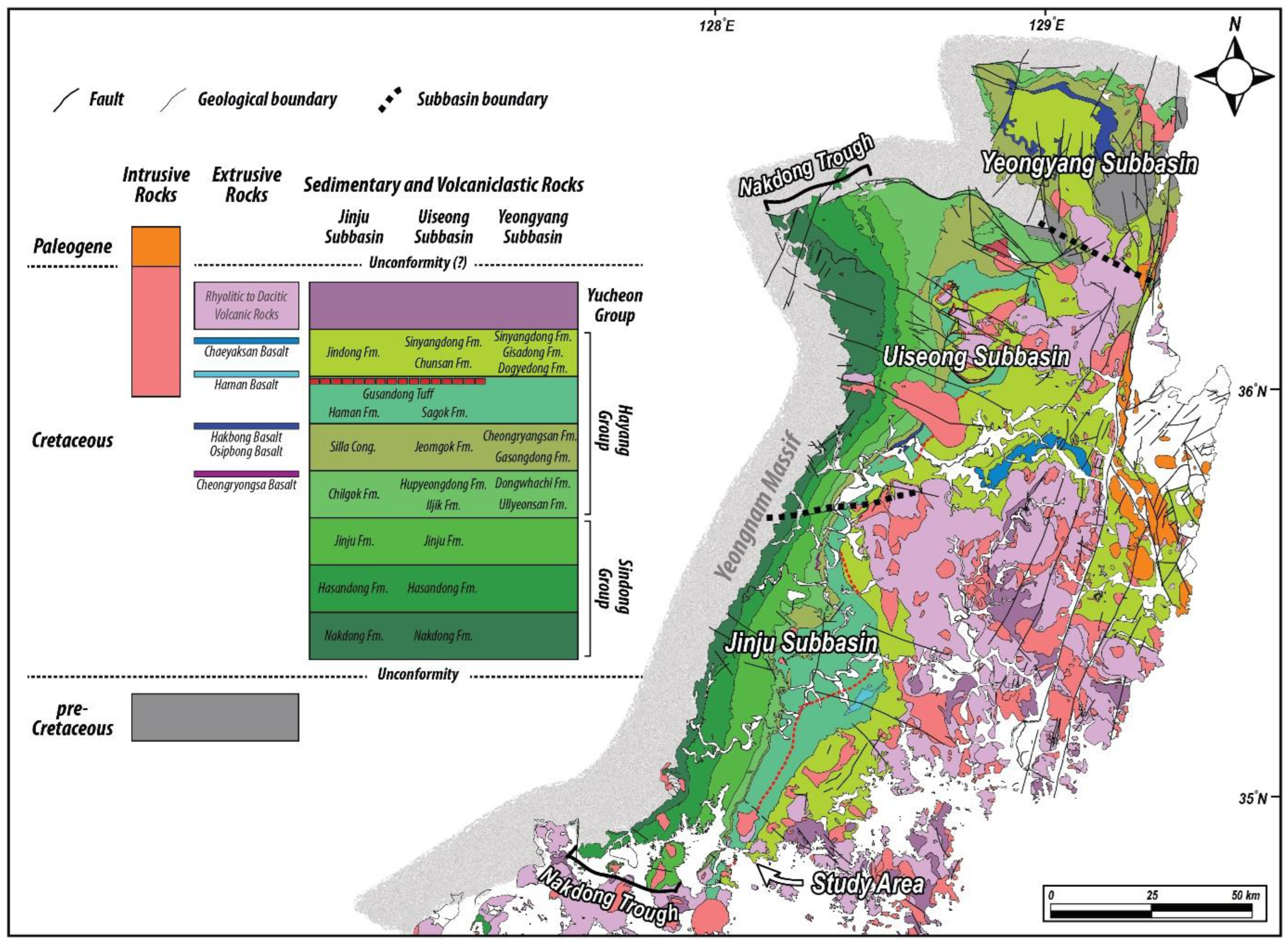
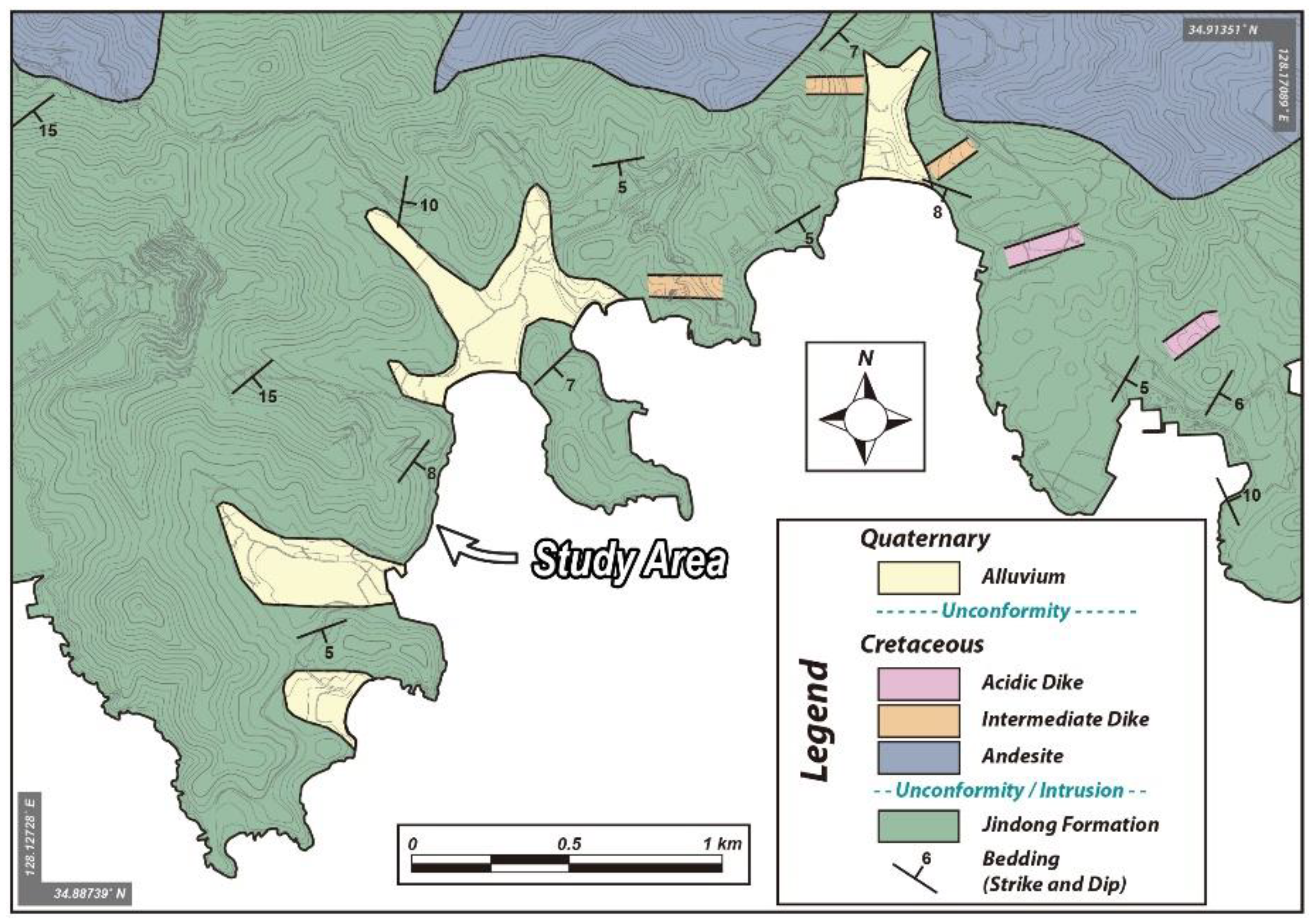

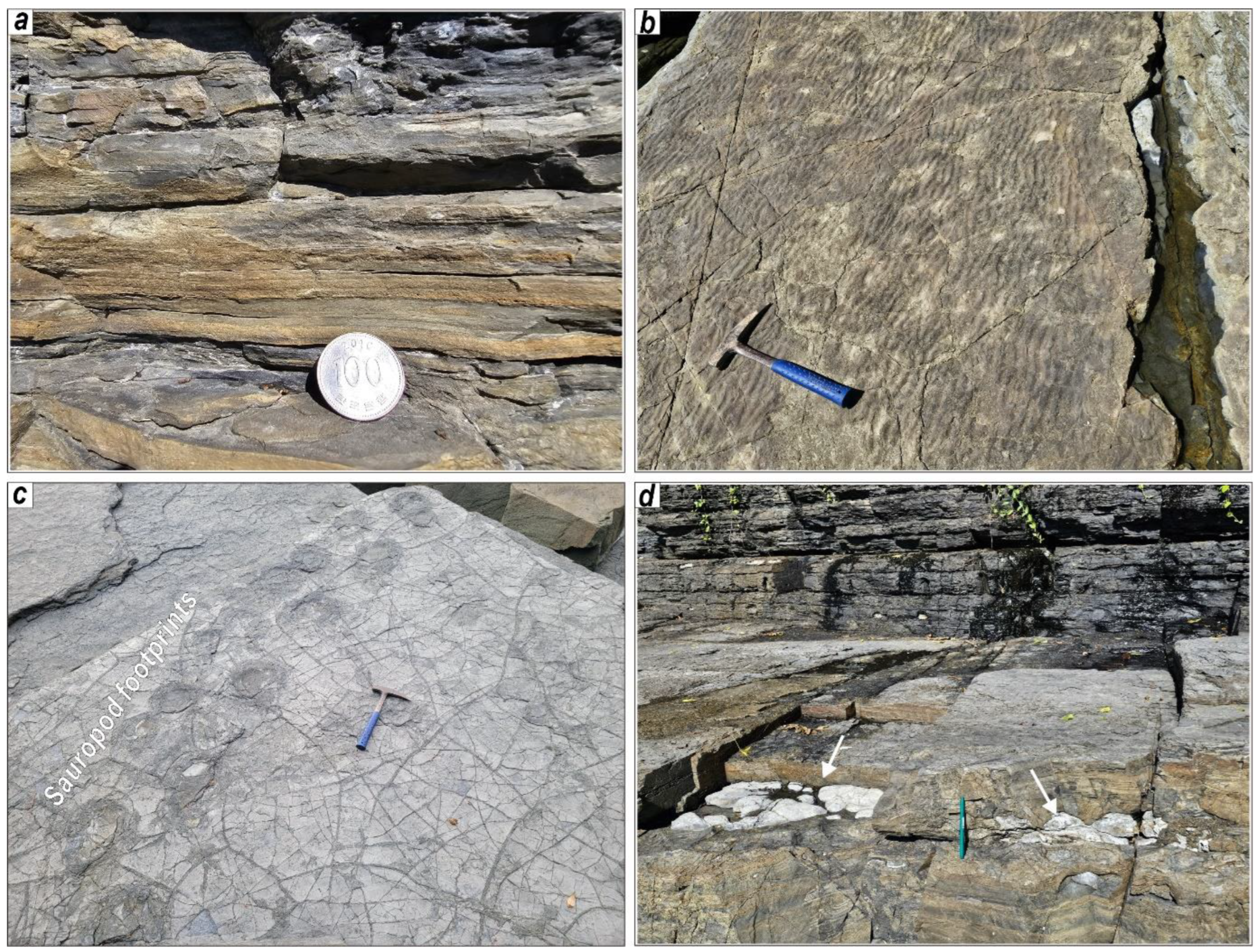

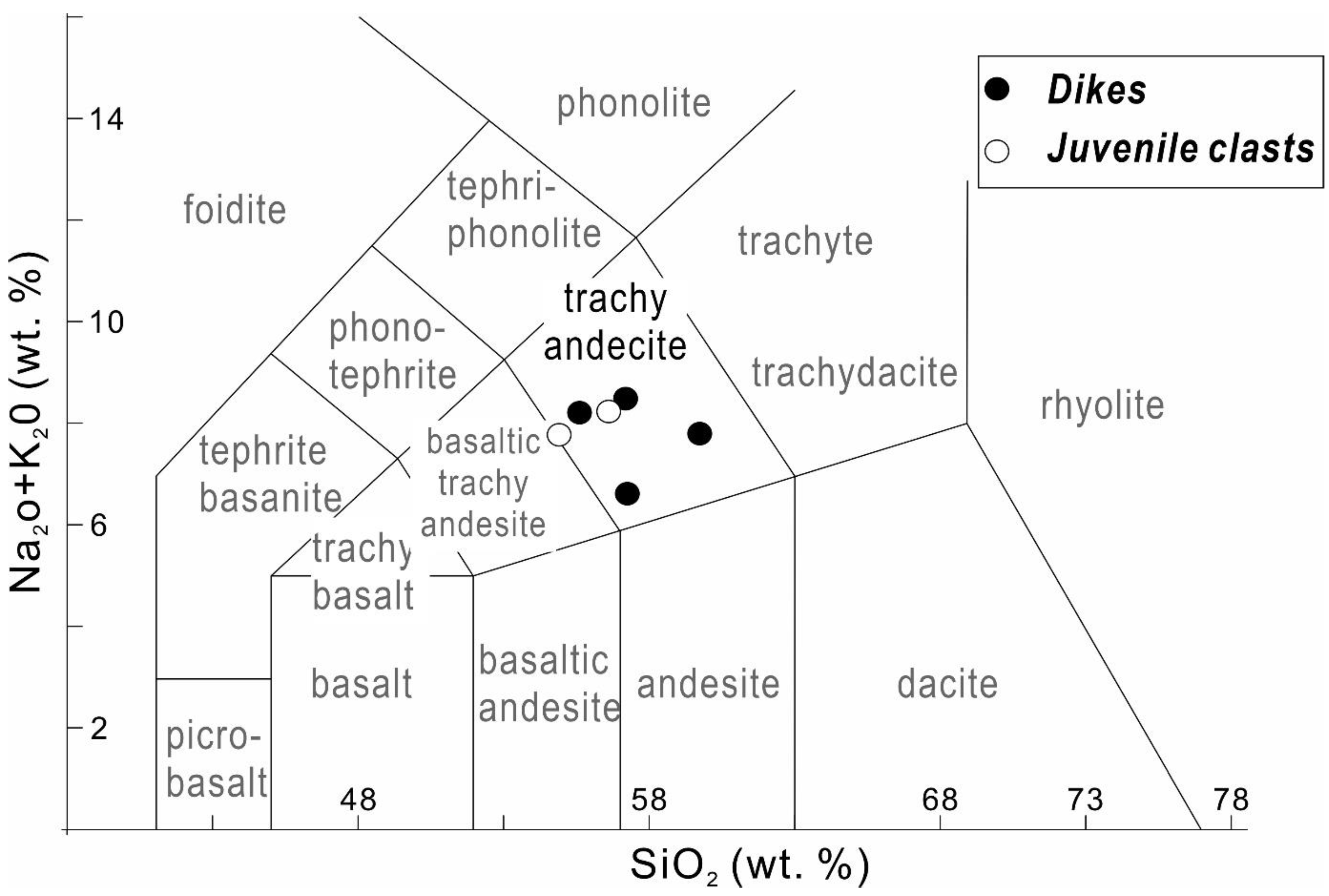

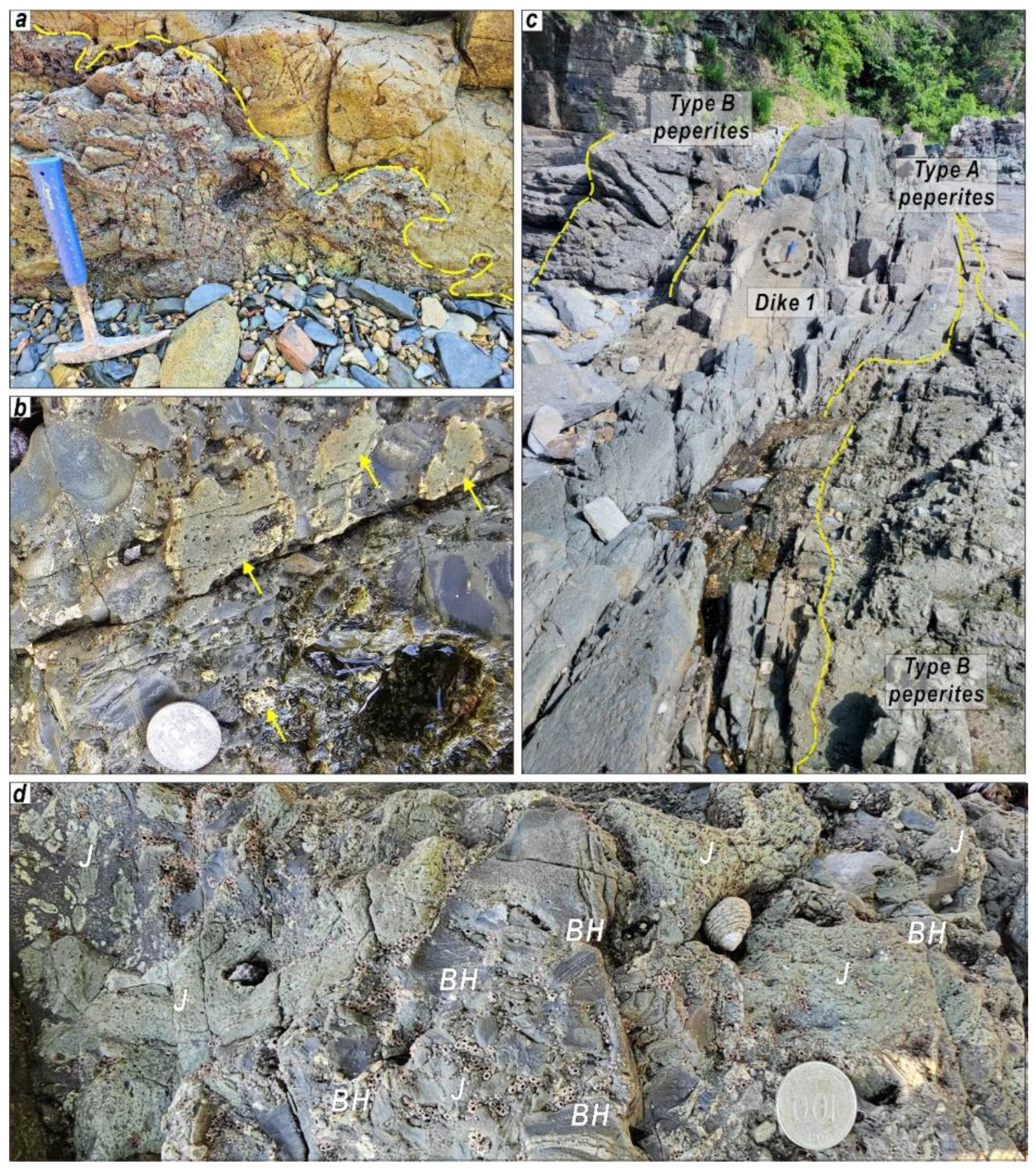
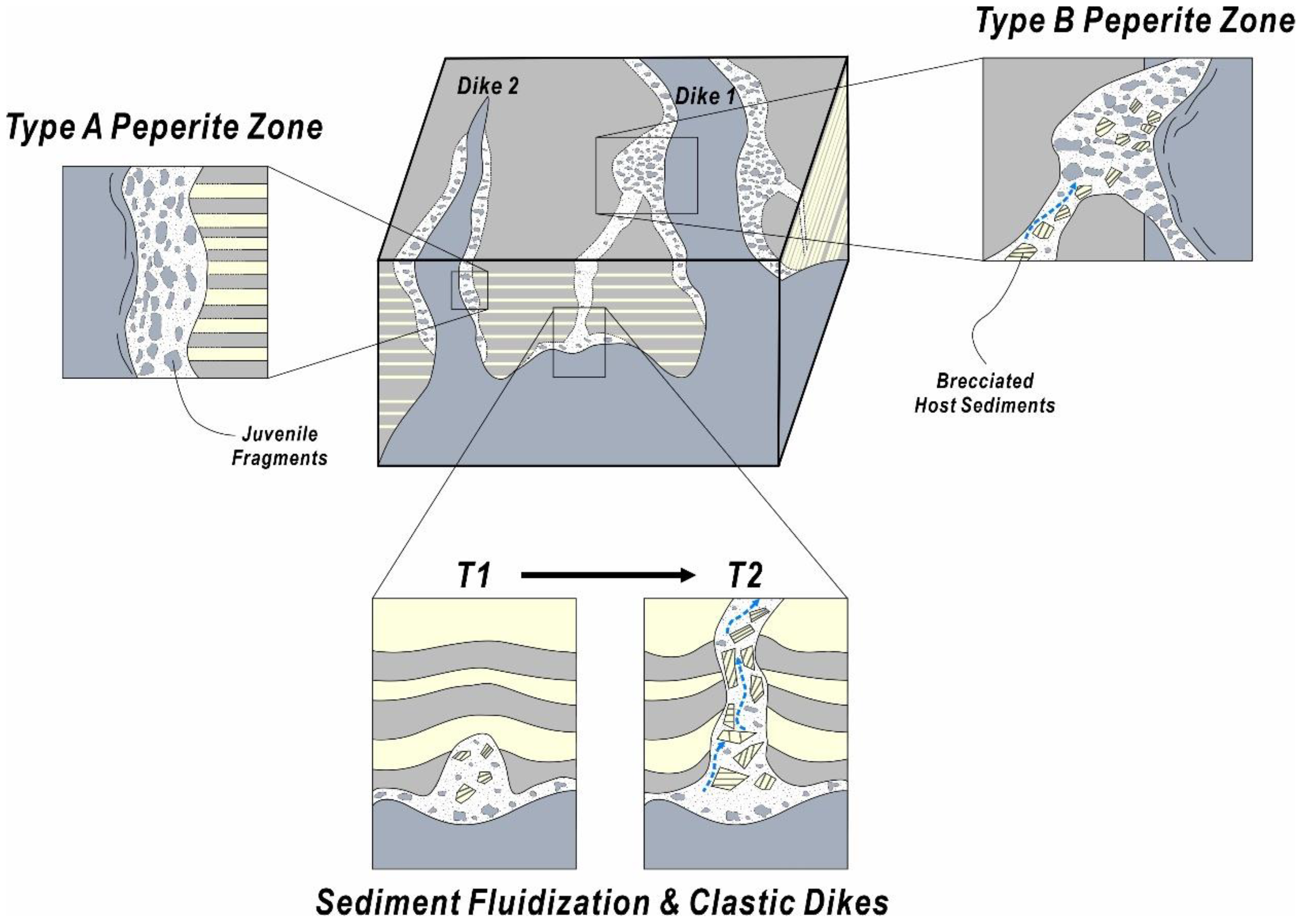
| Sample Locations | SiO2 | Al2O3 | Fe2O3 | CaO | MgO | K2O | Na2O | TiO2 | MnO | P2O5 | LOI* | Total | Remarks |
|---|---|---|---|---|---|---|---|---|---|---|---|---|---|
| 230601-A | 54.23 | 16.06 | 9.44 | 4.71 | 3.31 | 1.68 | 4.24 | 0.85 | 0.14 | 0.15 | 4.43 | 99.24 | Dike-1 |
| 230601-B | 56.96 | 14.94 | 8.78 | 3.12 | 3.04 | 1.37 | 5.78 | 0.77 | 0.18 | 0.16 | 4.41 | 99.51 | Dike-1 |
| 230601-F | 53.22 | 17.90 | 8.44 | 2.14 | 3.42 | 1.98 | 5.81 | 0.77 | 0.12 | 0.20 | 5.31 | 99.31 | Juvenile fragment |
| 230601-G | 50.96 | 16.15 | 7.83 | 5.96 | 3.61 | 0.86 | 6.28 | 0.67 | 0.15 | 0.18 | 6.56 | 99.21 | Juvenile fragment |
| 230601-H | 52.49 | 18.12 | 8.17 | 3.58 | 3.21 | 2.45 | 5.18 | 0.78 | 0.13 | 0.17 | 4.81 | 99.09 | Dike-1 |
| 230601-I | 53.87 | 18.31 | 6.41 | 3.91 | 2.82 | 2.50 | 5.55 | 0.76 | 0.07 | 0.17 | 4.53 | 98.90 | Dike-2 |
Disclaimer/Publisher’s Note: The statements, opinions and data contained in all publications are solely those of the individual author(s) and contributor(s) and not of MDPI and/or the editor(s). MDPI and/or the editor(s) disclaim responsibility for any injury to people or property resulting from any ideas, methods, instructions or products referred to in the content. |
© 2024 by the authors. Licensee MDPI, Basel, Switzerland. This article is an open access article distributed under the terms and conditions of the Creative Commons Attribution (CC BY) license (https://creativecommons.org/licenses/by/4.0/).
Share and Cite
Kim, M.-C.; Gihm, Y.S. Fluidal Peperites Recorded in the Cretaceous Lacustrine Sediments in the Southern Korean Peninsula: Syn-Magmatic Sediment Fluidization and Its Influence on the Peperite Formation. Minerals 2024, 14, 951. https://doi.org/10.3390/min14090951
Kim M-C, Gihm YS. Fluidal Peperites Recorded in the Cretaceous Lacustrine Sediments in the Southern Korean Peninsula: Syn-Magmatic Sediment Fluidization and Its Influence on the Peperite Formation. Minerals. 2024; 14(9):951. https://doi.org/10.3390/min14090951
Chicago/Turabian StyleKim, Min-Cheol, and Yong Sik Gihm. 2024. "Fluidal Peperites Recorded in the Cretaceous Lacustrine Sediments in the Southern Korean Peninsula: Syn-Magmatic Sediment Fluidization and Its Influence on the Peperite Formation" Minerals 14, no. 9: 951. https://doi.org/10.3390/min14090951
APA StyleKim, M.-C., & Gihm, Y. S. (2024). Fluidal Peperites Recorded in the Cretaceous Lacustrine Sediments in the Southern Korean Peninsula: Syn-Magmatic Sediment Fluidization and Its Influence on the Peperite Formation. Minerals, 14(9), 951. https://doi.org/10.3390/min14090951




